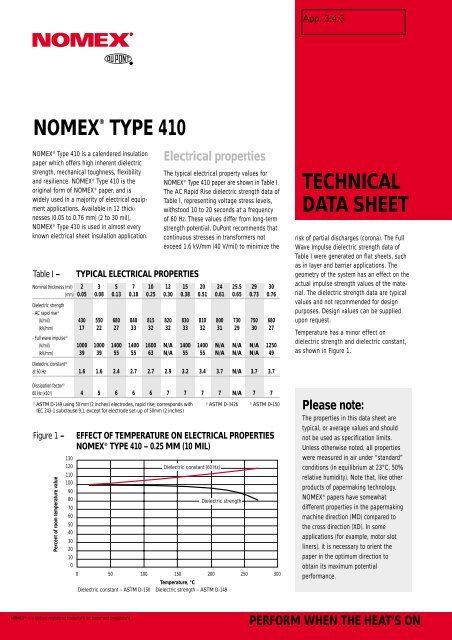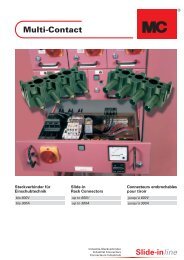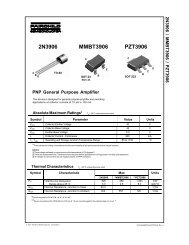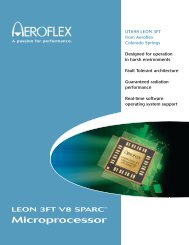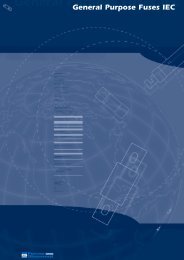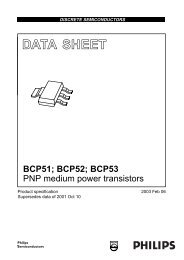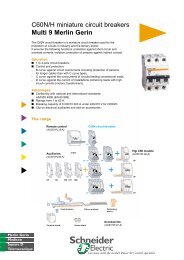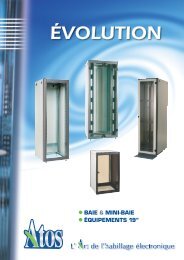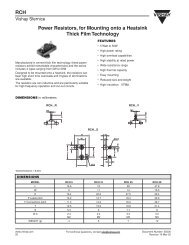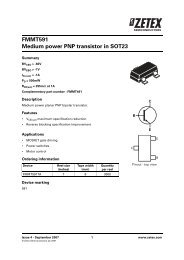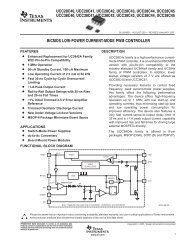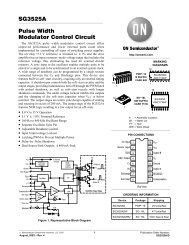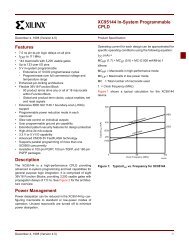TECHNICAL DATA SHEET NOMEX® TYPE 410 - TE-EPC-LPC
TECHNICAL DATA SHEET NOMEX® TYPE 410 - TE-EPC-LPC
TECHNICAL DATA SHEET NOMEX® TYPE 410 - TE-EPC-LPC
You also want an ePaper? Increase the reach of your titles
YUMPU automatically turns print PDFs into web optimized ePapers that Google loves.
NOMEX ® <strong>TYPE</strong> <strong>410</strong><br />
NOMEX ® Type <strong>410</strong> is a calendered insulation<br />
paper which offers high inherent dielectric<br />
strength, mechanical toughness, flexibility<br />
and resilience. NOMEX ® Type <strong>410</strong> is the<br />
original form of NOMEX ® paper, and is<br />
widely used in a majority of electrical equipment<br />
applications. Available in 12 thicknesses<br />
(0.05 to 0.76 mm) (2 to 30 mil),<br />
NOMEX ® Type <strong>410</strong> is used in almost every<br />
known electrical sheet insulation application.<br />
Table I –<br />
TYPICAL ELECTRICAL PROPERTIES<br />
Electrical properties<br />
The typical electrical property values for<br />
NOMEX ® Type <strong>410</strong> paper are shown in Table I.<br />
The AC Rapid Rise dielectric strength data of<br />
Table I, representing voltage stress levels,<br />
withstood 10 to 20 seconds at a frequency<br />
of 60 Hz. These values differ from long-term<br />
strength potential. DuPont recommends that<br />
continuous stresses in transformers not<br />
exceed 1.6 kV/mm (40 V/mil) to minimize the<br />
Nominal thickness (mil) 2 3 5 7 10 12 15 20 24 25.5 29 30<br />
(mm) 0.05 0.08 0.13 0.18 0.25 0.30 0.38 0.51 0.61 0.65 0.73 0.76<br />
Dielectric strength<br />
- AC rapid rise (1)<br />
(V/mil) 430 550 680 840 815 820 830 810 800 730 750 680<br />
(kV/mm) 17 22 27 33 32 32 33 32 31 29 30 27<br />
- Full wave impulse (2)<br />
(V/mil) 1000 1000 1400 1400 1600 N/A 1400 1400 N/A N/A N/A 1250<br />
(kV/mm) 39 39 55 55 63 N/A 55 55 N/A N/A N/A 49<br />
<strong><strong>TE</strong>CHNICAL</strong><br />
<strong>DATA</strong> <strong>SHEET</strong><br />
risk of partial discharges (corona). The Full<br />
Wave Impulse dielectric strength data of<br />
Table I were generated on flat sheets, such<br />
as in layer and barrier applications. The<br />
geometry of the system has an effect on the<br />
actual impulse strength values of the material.<br />
The dielectric strength data are typical<br />
values and not recommended for design<br />
purposes. Design values can be supplied<br />
upon request.<br />
Temperature has a minor effect on<br />
dielectric strength and dielectric constant,<br />
as shown in Figure 1.<br />
Dielectric constant (3)<br />
at 60 Hz 1.6 1.6 2.4 2.7 2.7 2.9 3.2 3.4 3.7 N/A 3.7 3.7<br />
Dissipation factor (3)<br />
60 Hz (x10 -3 ) 4 5 6 6 6 7 7 7 7 N/A 7 7<br />
1)<br />
ASTM D-149 using 50 mm (2 inches) electrodes, rapid rise; corresponds with<br />
IEC 243-1 subclause 9.1, except for electrode set-up of 50mm (2 inches)<br />
Figure 1 –<br />
Percent of room temperature value<br />
130<br />
120<br />
110<br />
100<br />
90<br />
80<br />
70<br />
60<br />
50<br />
40<br />
30<br />
20<br />
10<br />
0<br />
EFFECT OF <strong>TE</strong>MPERATURE ON ELECTRICAL PROPERTIES<br />
NOMEX ® <strong>TYPE</strong> <strong>410</strong> – 0.25 MM (10 MIL)<br />
Dielectric constant (60 Hz)<br />
2)<br />
ASTM D-3426<br />
3)<br />
ASTM D-150<br />
Dielectric strength<br />
0 50 100 150 200 250 300<br />
Temperature, °C<br />
Dielectric constant – ASTM D-150 Dielectric strength – ASTM D-149<br />
Please note:<br />
The properties in this data sheet are<br />
typical, or average values and should<br />
not be used as specification limits.<br />
Unless otherwise noted, all properties<br />
were measured in air under “standard”<br />
conditions (in equilibrium at 23°C, 50%<br />
relative humidity). Note that, like other<br />
products of papermaking technology,<br />
NOMEX ® papers have somewhat<br />
different properties in the papermaking<br />
machine direction (MD) compared to<br />
the cross direction (XD). In some<br />
applications (for example, motor slot<br />
liners), it is necessary to orient the<br />
paper in the optimum direction to<br />
obtain its maximum potential<br />
performance.<br />
NOMEX ® is a DuPont registered trademark for paper and pressboard<br />
PERFORM WHEN THE HEAT’S ON
Variations in frequency up to 10 4 Hz have<br />
essentially no effect on the dielectric<br />
constant of NOMEX ® Type <strong>410</strong> paper. The<br />
effects of temperature and frequency on<br />
dissipation factor of dry NOMEX ® Type <strong>410</strong> –<br />
0.25 mm (10 mil) paper are shown in Figure 2.<br />
The 60 Hz dissipation factors of thinner<br />
papers are essentially the same as those for<br />
0.25 mm (10 mil) at temperatures up to<br />
200°C. At higher temperatures and<br />
frequencies, the thicker papers have<br />
somewhat higher dissipation factors than<br />
those shown for the 0.25 mm (10 mil).<br />
Surface and Volume Resistivities of dry<br />
NOMEX ® Type <strong>410</strong> – 0.25 mm (10 mil) paper<br />
are shown in Figure 3 as functions of<br />
temperature. The corresponding values for<br />
other thicknesses of NOMEX ® Type <strong>410</strong> are<br />
very similar.<br />
The relatively minor effects of moisture<br />
(humidity) on the electrical properties of<br />
NOMEX ® Type <strong>410</strong> – 0.25 mm (10 mil) are<br />
shown in Table II.<br />
Table II –<br />
0,05<br />
HUMIDITY EFFECTS ON ELECTRICAL PROPERTIES<br />
NOMEX ® <strong>TYPE</strong> <strong>410</strong> – 0.25 MM (10 MIL)<br />
Relative<br />
humidity (%) Oven Dry 50 96<br />
Dielectric strength 1)<br />
(V/mil) 850 815 780<br />
(kV/mm) 33.5 32.1 30.7<br />
Dielectric constant 2)<br />
at 60 Hz 2.5 2.7 3.2<br />
at 1 kHz 2.3 2.6 3.1<br />
Dissipation factor 2)<br />
at 60 Hz (x 10 -3 ) 6 6 11<br />
at 1 Hz (x 10 -3 ) 13 14 25<br />
Volume resistivity 3)<br />
1)<br />
ASTM D-149 using 50 mm (2 inches) electrodes, rapid rise; corresponds with<br />
IEC 243-1 subclause 9.1, except for electrode set-up of 50mm (2 inches)<br />
Figure 2 –<br />
2)<br />
ASTM D-150<br />
3)<br />
ASTM D-257<br />
DISSIPATION FACTOR VS. <strong>TE</strong>MPERATURE AND<br />
FREQUENCY NOMEX ® <strong>TYPE</strong> <strong>410</strong> – 0.25 MM (10 MIL)<br />
(Ohm.cm) 6x10 16 2x10 16 2x10 14 ASTM D-257<br />
0,04<br />
60 Hz<br />
10 2 Hz<br />
Dissipation factor<br />
0,03<br />
0,02<br />
0,01<br />
10 3 Hz<br />
10 4 Hz<br />
0,00<br />
0 50 100 150 200 250 300<br />
Temperature, °C<br />
ASTM D-150<br />
Figure 3 –<br />
RESISTIVITY VS. <strong>TE</strong>MPERATURE<br />
NOMEX ® <strong>TYPE</strong> <strong>410</strong> – 0.25 MM (10 MIL)<br />
10 19<br />
10 18<br />
10 17 0 50 100 150 200 250 300<br />
Volume resistivity (ohm-cm) or<br />
surface resistivity (ohm/square)<br />
10 16<br />
10 15<br />
10 14<br />
10 13<br />
10 12<br />
10 11<br />
Surface resistivity<br />
Volume resistivity<br />
10 10<br />
Temperature, °C
Like other organic insulating materials,<br />
NOMEX ® paper is gradually eroded under<br />
attack by corona discharges. Corona intensity<br />
is a function of voltage stress, which,<br />
in turn, depends almost entirely on design<br />
parameters such as spacing between circuit<br />
elements, smooth vs. sharp contours, etc.<br />
Although corona does not occur during<br />
normal operation of properly designed<br />
electrical equipment, any device may be<br />
subject to occasional overvoltages which<br />
produce brief corona discharges; and it is<br />
important that the insulation not fail<br />
prematurely under these conditions. The<br />
voltage endurance (time to failure under<br />
corona attack) of NOMEX ® Type <strong>410</strong> paper<br />
is superior to other commonly used organic<br />
insulations and even compares favorably<br />
with some inorganic compositions, as shown<br />
in Figure 4. These data were obtained in all<br />
cases on single layers of 0.25 mm (10 mil)<br />
materials at room temperature, 50%<br />
relative humidity, and 360 Hz frequency.<br />
Times to failure at 50-60 Hz are<br />
approximately 6-7 times as long as<br />
indicated.<br />
Figure 4 –<br />
Stress in kV/mm<br />
Table III –<br />
24<br />
20<br />
16<br />
12<br />
8<br />
4<br />
0<br />
VOLTAGE ENDURANCE OF VARIOUS INSULATING MA<strong>TE</strong>RIALS<br />
SINGLE LAYER NOMEX ® <strong>TYPE</strong> <strong>410</strong> – 0.25 MM (10 MIL)<br />
Rag paper<br />
Polyester<br />
(mat/film/mat)<br />
100% epoxy<br />
impregnation<br />
Glass/mica splittings/glass<br />
(with silicone)<br />
Polyester film<br />
.01 .1 1 10 100 1000 10000<br />
TYPICAL MECHANICAL PROPERTIES<br />
Absestos paper<br />
Time (in hours) for 5th of 10 failures<br />
NOMEX ® paper<br />
Type <strong>410</strong><br />
ASTM D-2275 360 Hz<br />
Nominal thickness (mil) 2 3 5 7 10 12 15 20 24 25.5 29 30<br />
(mm) 0.05 0.08 0.13 0.18 0.25 0.30 0.38 0.51 0.61 0.65 0.73 0.76 Test method<br />
Typical thickness 1) (mil) 2.2 3.1 5.2 7.2 10.2 12.2 15.2 20.3 24.1 25.4 28.7 30.4<br />
(mm) 0.06 0.08 0.13 0.18 0.26 0.31 0.39 0.52 0.61 0.65 0.73 0.77 ASTM D-374<br />
Basis weight (g/m 2 ) 41 63 116 175 249 309 397 547 693 696 854 847 ASTM D-646<br />
Density (g/cc) 0.72 0.80 0.87 0.95 0.96 1.00 1.03 1.06 1.13 1.08 1.17 1.10<br />
Tensile strength (N/cm)<br />
MD 39 65 137 219 285 378 459 606 741 758 860 841<br />
XD 18 32 66 111 152 196 252 354 497 524 630 595<br />
Elongation (%) MD 9 11 15 18 19 22 19 20 18 19 16 17<br />
XD 6 8 12 14 15 17 14 16 14 16 12 13<br />
Elmendorf Tear (N)<br />
MD 0.8 1.2 3.4 3.9 6.0 7.4 9.5 14.2 N/A N/A N/A N/A<br />
XD 1.6 2.3 5.2 7.4 10.8 14.2 17.2 23.7 N/A N/A N/A N/A<br />
Initial Tear 2) MD 11 16 33 50 71 93 116 163 201 209 252 251<br />
strength (N) XD 6 8 17 27 42 55 74 113 157 159 199 200<br />
ASTM D-828<br />
ASTM D-828<br />
TAPPI-414<br />
ASTM D -1004<br />
Shrinkage MD 2.2 1.1 0.9 0.6 0.4 0.4 0.3 0.1 0.0 N/A 0.0 0.2<br />
at 300°C (%) XD 0.1 0.0 0.0 0.2 0.1 0.2 0.2 0.0 0.0 0.0 0.0 0.0<br />
1)<br />
Method D; 17 N/cm 2<br />
2)<br />
Data presented for Initial Tear Strength is listed in the direction of the sample per<br />
ASTM D-1004. The tear is 90 degrees to sample direction - hence for papers with<br />
a higher reported MD ITR, the paper will be tougher to tear in the cross direction.<br />
MD = machine direction of paper<br />
XD = cross direction of paper<br />
PERFORM WHEN THE HEAT’S ON
Mechanical properties<br />
The typical mechanical property values for<br />
NOMEX ® Type <strong>410</strong> paper are shown in<br />
Table III. The effects of high temperatures<br />
on tensile strength and elongation are<br />
illustrated in Figure 5. NOMEX ® sheet<br />
structures also retain good mechanical properties<br />
at very low temperatures. At the<br />
boiling point of liquid nitrogen (minus 196°C<br />
or 77K) the tensile strength of NOMEX ®<br />
Type <strong>410</strong> – 0.25 mm (10 mil) paper exceeds<br />
its room-temperature value by 30 to 60%<br />
(depending on direction), while elongation<br />
to break is still greater than 3% (better<br />
than most inorganic materials at room<br />
temperature). This allows NOMEX ® Type<br />
<strong>410</strong> to work well in cryogenic applications.<br />
Water is a mild plasticizer for NOMEX ®<br />
paper. The effects of moisture (humidity) on<br />
tensile strength and elongation are shown<br />
in Figure 6. Like elongation, the tear<br />
strength and toughness of NOMEX ® Type<br />
<strong>410</strong> paper are also improved at higher<br />
moisture contents.<br />
The dimensions of bone-dry NOMEX ® Type<br />
<strong>410</strong> paper exposed to 95% relative humidity<br />
conditions will increase at most 1% in the<br />
machine direction and 2% in the cross<br />
direction (due to moisture absorption). This<br />
swelling is largely reversible when the<br />
paper is redried. The rate of change in<br />
dimensions will depend, of course, on paper<br />
thickness and configuration (for example,<br />
individual sheets versus tightly wound<br />
rolls). Variations in environmental humidity<br />
will usually produce dimensional changes<br />
which will be less than 1%. However, even<br />
small dimensional changes, especially if<br />
they are non-uniform, can cause or accentuate<br />
non-flatness (sag, puckers, etc.) in the<br />
sheet, which can cause problems in critical<br />
operations like laminating or creping.<br />
Therefore, NOMEX ® paper intended for<br />
these applications should be kept sealed in<br />
its protective polyethylene wrapper, to<br />
maintain uniform moisture content, until<br />
just before use.<br />
Figure 5 –<br />
Percent of room temperature value<br />
Figure 6 –<br />
Percent of bone-dry value<br />
140<br />
130<br />
120<br />
110<br />
100<br />
90<br />
80<br />
70<br />
60<br />
50<br />
40<br />
30<br />
20<br />
10<br />
EFFECT OF <strong>TE</strong>MPERATURE ON MECHANICAL PROPERTIES<br />
NOMEX ® <strong>TYPE</strong> <strong>410</strong> – 0.25 MM (10 MIL)<br />
0<br />
0 50 100 150 200 250<br />
300<br />
Temperature, °C<br />
ASTM D-828<br />
140<br />
120<br />
100<br />
80<br />
60<br />
40<br />
20<br />
0<br />
Tensile elongation (MD)<br />
EFFECT OF MOISTURE ON MECHANICAL PROPERTIES<br />
NOMEX ® <strong>TYPE</strong> <strong>410</strong> – 0.25 MM (10 MIL)<br />
Tensile elongation (MD)<br />
Tensile strength (MD)<br />
0 10 20 30 40 50 60 70 80 90 100 120<br />
Relative humidity (%)<br />
Tensile strength (MD)<br />
ASTM D-828
Thermal properties<br />
The effects of long-time exposure of<br />
NOMEX ® Type <strong>410</strong> – 0.25 mm (10 mil) to<br />
high temperature on important electrical and<br />
mechanical properties are shown in figures<br />
7, 8 and 9. These Arrhenius plots of aging<br />
behavior are the basis for the recognition of<br />
NOMEX ® paper as a 220°C insulation by<br />
Underwriters Laboratories, the U.S. Navy,<br />
and others, and are confirmed by more than<br />
35 years commercial experience. These<br />
curves can also be extrapolated to higher<br />
temperatures. Measurements show, for<br />
example, that NOMEX ® paper Type <strong>410</strong> will<br />
maintain 12 kV/mm (300 V/mil) dielectric<br />
strength for several hours at 400°C, which is<br />
the performance predicted by the Arrhenius<br />
plot.<br />
Figure 7 –<br />
Aging time, hours to 12 kV/mm (3o V/mil)<br />
dielectric strength<br />
USEFUL LIFE VS. <strong>TE</strong>MPERATURE<br />
NOMEX ® <strong>TYPE</strong> <strong>410</strong> – 0.25 MM (10 MIL)<br />
10 6<br />
10 5<br />
Log time = 8262 – 11,44<br />
10 4<br />
°C + 273<br />
10 3<br />
10 2<br />
100 140 180 220 260 300 340 380<br />
Temperature, °C<br />
ASTM D-1830 (curved electrodes)<br />
Figure 8 –<br />
USEFUL LIFE VS. <strong>TE</strong>MPERATURE<br />
NOMEX ® <strong>TYPE</strong> <strong>410</strong> – 0.25 MM (10 MIL)<br />
10 6 100 140 180 220 260 340 380<br />
Aging time, hours to 50% of initial strength<br />
in machine direction<br />
10 5<br />
10 4<br />
10 3<br />
7461<br />
Log time =<br />
– 10,40<br />
°C + 273<br />
10 2<br />
Temperature, °C<br />
300<br />
Tested per UL-746<br />
PERFORM WHEN THE HEAT’S ON
The thermal conductivity of NOMEX ®<br />
Type <strong>410</strong> – 0.25 mm (10 mil) paper is shown<br />
in Figure 10. These values are similar to<br />
those for cellulosic papers, and, as with<br />
most materials, are primarily determined by<br />
specific gravity (density). Therefore, thinner<br />
grades of NOMEX ® Type <strong>410</strong> paper, which<br />
are somewhat less dense, will have slightly<br />
lower conductivity, and thicker grades,<br />
which are denser, will have higher conductivities,<br />
as is seen in Table IV. The total<br />
system construction may affect the overall<br />
thermal conductivity, therefore, care should<br />
be taken in applying individual sheet data<br />
to actual situations. For example, two sheet<br />
insulations with identical thermal conductivities<br />
may have quite different effects on<br />
heat transfer from a coil, due to the<br />
differences in stiffness or winding tension<br />
which affect the spacing between the<br />
insulation layers.<br />
Figure 9 –<br />
Aging time, hours to 50% of initial elongation<br />
in machine direction<br />
USEFUL LIFE VS. <strong>TE</strong>MPERATURE<br />
NOMEX ® <strong>TYPE</strong> <strong>410</strong> – 0.25 MM (10 MIL)<br />
10 6<br />
10 5<br />
10 4<br />
9851<br />
Log time =<br />
– 14,97<br />
10 3<br />
°C + 273<br />
10 2<br />
100 140 180 220 260 300 340 380<br />
Temperature, °C Tested per UL 746<br />
Figure 10 –<br />
THERMAL CONDUCTIVITY VS. <strong>TE</strong>MPERATURE<br />
NOMEX ® <strong>TYPE</strong> <strong>410</strong> – 0.25 MM (10 MIL)<br />
Thermal conductivity (mWatt/meter K<br />
260<br />
240<br />
220<br />
200<br />
180<br />
160<br />
140<br />
120<br />
100<br />
80<br />
60<br />
40<br />
20<br />
0<br />
50 100 150 200 250 300<br />
Temperature, °C<br />
ASTM E-1530<br />
Table IV –<br />
THERMAL CONDUCTIVITY<br />
Nominal thickness (mil) 2 3 5 7 10 15 20 30<br />
(mm) 0.05 0.08 0.13 0.18 0.25 0.38 0.51 0.76<br />
Density<br />
g/cc 0.72 0.80 0.87 0.95 0.96 1.03 1.06 1.10<br />
Thermal conductivity 1)<br />
(mWatt/meter K) 103 114 123 143 139 149 157 175<br />
1)<br />
All data taken at 150°C
Chemical stability<br />
The compatibility of NOMEX ® paper and<br />
pressboard with virtually all classes of electrical<br />
varnishes and adhesives (polyimides,<br />
silicones, epoxies, polyesters, acrylics,<br />
phenolics, synthetic rubbers, etc.), as well<br />
as other components of electrical equipment,<br />
is demonstrated by the many ULrecognized<br />
systems comprising NOMEX ® , as<br />
well as longstanding commercial experience.<br />
NOMEX ® papers are also fully compatible<br />
(and in commercial use) with transformer<br />
fluids (mineral and silicone oils and other<br />
synthetics) and with lubricating oils and<br />
refrigerants used in hermetic systems.<br />
Common industrial solvents (alcohols,<br />
ketones, acetone, toluene, xylene) have a<br />
slight softening and swelling effect on<br />
NOMEX ® Type <strong>410</strong> paper, similar to that of<br />
water. These effects are mainly reversible<br />
when the solvent is removed.<br />
The Limiting Oxygen Index (LOI) of NOMEX ®<br />
paper Type <strong>410</strong> at room temperature ranges<br />
between 27 and 32% (depending on thickness<br />
and density), and at 220°C, from 22 to<br />
25%. Materials with LOI above 20.8%<br />
(ambient air) will not support combustion.<br />
NOMEX ® Type <strong>410</strong> must be heated between<br />
240°C and 350°C (again depending on<br />
thickness) before its LOI declines below the<br />
flammability threshold. The LOI data for<br />
Type <strong>410</strong> – 0.13 mm (5 mil) is shown in<br />
Figure 11.<br />
The effect of 6400 megarads (64 Mgy) of<br />
2 MeV beta radiation on the mechanical<br />
and electrical properties of NOMEX ® Type<br />
<strong>410</strong> paper is shown in Table V. (By comparison,<br />
a laminate of polyester film and<br />
polyester mat of the same thickness, 100%<br />
epoxy-impregnated, crumbled after 800<br />
megarads, or 8 Mgy). Similar results were<br />
obtained on exposure to gamma radiation.<br />
The outstanding radiation resistance of<br />
NOMEX ® paper has led to its use in critical<br />
control equipment for nuclear power<br />
installations.<br />
Figure 11 – LIMITING OXYGEN INDEX (LOI)<br />
NOMEX ® <strong>TYPE</strong> <strong>410</strong> – 0.13 MM (5 MIL)<br />
Limiting oxygen index, %<br />
Table V –<br />
35<br />
30<br />
25<br />
20<br />
15<br />
0 100 200 300 400<br />
Temperature, °C<br />
RADIATION RESISTANCE TO 2 MEV ELECTRONS (BETA RAYS)<br />
NOMEX ® <strong>TYPE</strong> <strong>410</strong> – 0.25 MM (10 MIL)<br />
(Mgy) Dose 0 1 2 4 8 16 32 64<br />
Tensile strength 1) MD 100 96 100 100 94 87 81 65<br />
(% of original) XD 100 100 99 99 97 86 81 69<br />
Elongation 1) MD 100 89 92 96 76 60 36 18<br />
(% of original) XD 100 92 91 88 82 47 27 16<br />
Dielectric (kV/mm)<br />
strength 2) 34 34 33 33 33 34 35 31<br />
Dielectric 60Hz 3.1 3.0 3.0 3.0 3.0 3.1 2.3 2.5<br />
constant 3) 1kHz 3.0 3.0 2.9 3.0 2.9 3.1 2.3 2.5<br />
10kHz 2.9 2.9 2.9 2.9 2.8 3.0 2.2 2.4<br />
Dielectric 60Hz 8 14 10 12 9 14 7 10<br />
Factor 3) 1kHz 13 16 15 16 13 16 11 13<br />
(x 10 -3 )<br />
10kHz 18 21 20 20 19 20 15 17<br />
1)<br />
ASTM D-828<br />
2)<br />
ASTM D-149 with a 6.4 mm (1.4 inches) diameter electrode<br />
3)<br />
ASTM D-150<br />
ASTM D-2863<br />
PERFORM WHEN THE HEAT’S ON
Europe<br />
DuPont NOMEX ®<br />
P.O. Box 50<br />
CH-1218 le Grand Saconnex<br />
Geneva, Switzerland<br />
Tel: ++41-22-717-5111<br />
Fax: ++41-22-717-6218<br />
e-mail: info.nomex@che.dupont.com<br />
Japan<br />
DuPont NOMEX ®<br />
ARCO Tower,<br />
8-1, Shimomeguro I-chome<br />
Meguro-ku, Tokyo 153<br />
Japan<br />
Tel: 81-3-5434-6609<br />
Fax: 81-3-5434-6605<br />
Hong Kong<br />
DuPont China Limited<br />
1122 New World office Building, East Wing<br />
24 Salisbury Road<br />
Tsimshatsui<br />
Kowloon<br />
Hong Kong<br />
Tel: +852-2734 5363<br />
Fax: +852-2734-5486<br />
e-mail: Sulla-S.F.Wan@HKG.dupont.com<br />
USA<br />
DuPont NOMEX ®<br />
Customer Inquiry Center<br />
5401 Jefferson Davis Highway<br />
Richmond, VA 23234<br />
Tel: (800) 453-8527<br />
(804) 383-4400<br />
Fax: (800) 787-7086<br />
Fax: (804) 383-3963<br />
E-mail: afscdt@usa.dupont.com<br />
Canada<br />
DuPont NOMEX ®<br />
P.O. Box 2200<br />
Streetsville Postal Station<br />
7070 Mississauga Road<br />
Mississauga, Ontario, L5M 2H3<br />
Canada<br />
Tel: (905) 821-5193<br />
Fax: (905) 821-5177<br />
DuPont on the Web:<br />
www.dupont.com/nomex<br />
Product safety information is available upon request.<br />
This information corresponds to our current knowledge on the subject.<br />
It is offered solely to provide possible suggestions for your own experimentations.<br />
It is not intended, however, to substitute for any testing you<br />
may need to conduct to determine for yourself the suitability of our<br />
products for your particular purposes. This information may be subject to<br />
revision as new knowledge and experience becomes available. Since we<br />
cannot anticipate all variations in actual end-use conditions, DuPont<br />
makes no warranties and assumes no liability in connection with any use<br />
of this information. Nothing in this publication is to be considered as a<br />
license to operate under or a recommendation to infringe any patent right.<br />
L-12285 05/00<br />
NOMEX ® is a DuPont registered trademark for paper and pressboard<br />
PERFORM WHEN THE HEAT’S ON


